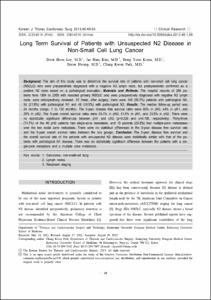Long Term Survival of Patients with Unsuspected N2 Disease in Non-Small Cell Lung Cancer
- Keimyung Author(s)
- Hwang, Il Seon; Park, Chang Kwon; Keum, Dong Yoon; Kim, Jae Bum
- Journal Title
- Korean Journal of Thoracic and Cardiovascular Surgery
- Issued Date
- 2013
- Volume
- 46
- Issue
- 1
- Keyword
- Carcinoma; non-small-cell lung; Lymph nodes; Neoplasm staging
- Abstract
- Background
The aim of this study was to determine the survival rate of patients with non-small cell lung cancer (NSCLC) who were preoperatively diagnosed with a negative N2 lymph node, but postoperatively confirmed as a positive N2 node based on a pathological evaluation.
Materials and Methods
The hospital records of 248 patients from 1994 to 2009 with resected primary NSCLC who were preoperatively diagnosed with negative N2 lymph node, were retrospectively reviewed. Of these, after surgery, there were 148 (59.7%) patients with pathological N0, 54 (21.8%) with pathological N1 and 46 (18.5%) with pathological N2.
Results
The median follow-up period was 24 months (range, 1 to 132 months). The 5-year disease free survival rates were 60% in pN0, 44% in pN1, and 29% in pN2. The 5-year overall survival rates were 63.1% in pN0, 51.9% in pN1, and 33.5% in pN2. There were no statistically significant differences between pN1 and pN2 (p=0.326 and p=0.106, respectively). Thirty-three (71.7%) of the 46 pN2 patients had single-zone metastasis, and 13 patients (28.3%) had multiple-zone metastases over the two nodal zone metastasis. There were no statistical differences in the 5-year disease free survival rate and the 5-year overall survival rates between the two groups.
Conclusion
The 5-year disease free survival and the overall survival rate of the patients with unsuspected N2 disease were statistically similar with that of the patients with pathological N1 disease. There was no statistically significant difference between the patients with a single-zone metastasis and a multiple zone metastasis.
Keywords: Carcinoma, non-small-cell lung; Lymph nodes; Neoplasm staging
Go to:
INTRODUCTION
Mediastinal nodal involvement is generally considered to be one of the most important prognostic factors in patients with non-small cell lung cancer (NSCLC). In patients with N2 disease, identified preoperatively, pulmonary resection is not recommended by the American College of Chest Physicians Evidence-Based Clinical Practice Guidelines [1]. However, the optimal treatment approach for clinical stage IIIA has been controversial, because N2 disease is defined just as the presence of metastasis in the ipsilateral mediastinal lymph node by the 7th American Joint Committee on Cancer tumor-node-metastasis (AJCC/TNM) staging for lung cancer [2]. Stage IIIA NSCLC, especially N2 disease, shows a broad spectrum of the disease. Several published reports have suggested that there were significant variabilities of the long term outcomes, according to the heterogeneity of N2 disease, such as a single N2 disease versus a multiple N2 disease, skip metastasis (negative N1 and positive N2 disease), the number of positive N2 disease, and unsuspected, occult or incidental N2 disease [3-11].
Recently, the nodal zone concept was proposed as a new descriptor of the intrathoracic lymph node by International Association for the Study of Lung Cancer (IASLC) [12]. The lymph node maps, which have been widely used for several decades, were classified by Mountain and Dressler [13], Naruke [14], and Naruke et al. [15]. However, there are several discrepancies in the definition of the nomenclature between the two classifications. The nodal zone concept was proposed as able to achieve uniformity, an accurate assessment of lymph node involvement, and to promote future analyses of a planned prospective international database.
The purpose of this study is to investigate the long term outcomes for patients with unsuspected N2 (negative N2 disease on the preoperative diagnosis, but positive N2 disease on the postoperative pathologic diagnosis) disease, and to identify the effects of the 'nodal zone' relationship to the long-term outcomes of unsuspected N2 disease.
- Publisher
- School of Medicine
- Citation
- Deok Heon Lee et al. (2013). Long Term Survival of Patients with Unsuspected N2 Disease in Non-Small Cell Lung Cancer. Korean Journal of Thoracic and Cardiovascular Surgery, 46(1), 49–55. doi: 10.5090/kjtcs.2013.46.1.49
- Type
- Article
- ISSN
- 2233-601X
- 파일 목록
-
-
Download
 oak-aaa-4555.pdf
기타 데이터 / 300.78 kB / Adobe PDF
oak-aaa-4555.pdf
기타 데이터 / 300.78 kB / Adobe PDF
-
Items in Repository are protected by copyright, with all rights reserved, unless otherwise indicated.